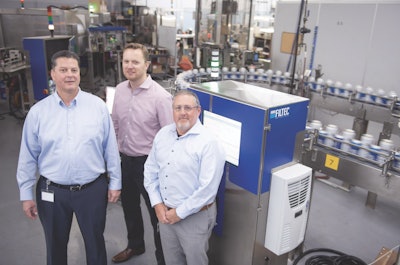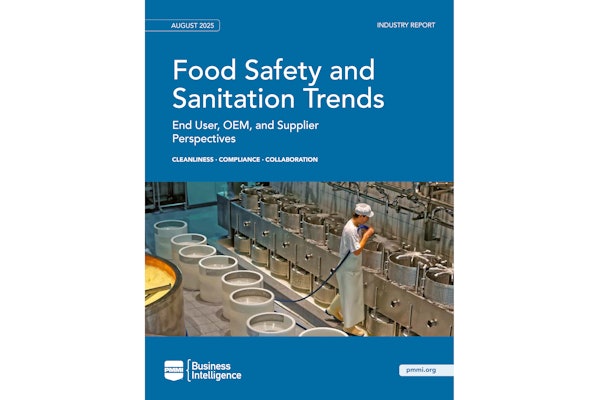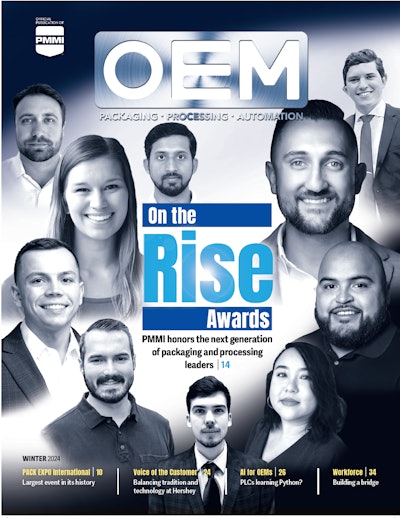When it’s the week before Christmas, one would think a plant floor would be empty and quiet, assuming workers have clocked out early to celebrate the holiday season. But it was quite the contrary for Torrance, California-based inline inspection equipment manufacturer FILTEC.
“We have a bunch of orders going out the door this week,” FILTEC marketing director Rhonda Nelson told OEM Magazine during a site visit to the facility. “We’ve been busy.”
The OEM is high in demand as the food, beverage and pharma industries it serves have new inspection challenges related to the consumer products they put in grocery stores and pharmacy shelves. One of the reasons FILTEC is a favorite to the large manufacturers it serves is due to its focus on safety.
“I spent 20 years working in the biotech industry with people who were doing cutting edge medical research,” says Scott McGinnis, vice president of global sales and marketing. “And here at FILTEC, we probably keep more people healthy before a beverage container hits their lips than the biotech companies do. You have no idea how much goes into making sure that bottle is safe.”
FILTEC was founded in 1960 by Fred Calhoun, who entered the test and inspection industry manufacturing fill level inspection technology for the beer and beverage industry using gamma rays as a radioactive source to penetrate the container and measure the penetration of the gamma source through the product. FILTEC soon became the standard for fill level inspection systems.
“Fred built a brand that was comparable to a Kleenex for facial tissues,” says Jim Kearbey, president and CEO of FILTEC. “If somebody was looking to buy a fill level machine, they would typically ask you to quote them a FILTEC and not a fill level device. He created that very strong brand recognition.”
Calhoun then started developing visual inspection solutions for the returnable glass markets, which the company still serves. These markets, where glass containers are filled, put into distribution, and then returned after the consumer finishes the product, are popular in most geographic regions outside the U.S. According to PMMI’s 2018 Beverage Trends in Packaging and Processing, returnable glass is a trend and process that may be adopted by more regions in the near future, including the U.S. FILTEC’s Empty Bottle Inspection (EBI) product line was especially helpful in this market because it could be used to inspect the container to make sure it was not damaged, so it could be recycled, rinsed, washed and then refilled.
Throughout the years, FILTEC has evolved from being a fill level company to a full line test and inspection equipment manufacturer with subsidiary offices in Mexico, Brazil, South Africa, Germany, Philippines, Thailand and Shanghai to handle global demand and support. And global expansion is just one area of growth, as the company has built out its technology portfolio, too.
Acquisition propels Filtec into new controls platform
After running FILTEC for a couple of years, Calhoun’s son, Steve, approached a number of companies to explore the sale of the business. In 2013, private equity firm SFW Capital Partners purchased FILTEC.
As the acquisition transpired, a new management team was also created. Kearbey, the company’s president and CEO, came to FILTEC in 2018 after working in the beverage industry for 34 years, where he also had experience in test and inspection. Similarly, McGinnis came from a background in life science and analytics. Also part of the new management team is senior product manager Christian Beck, who has been with FILTEC for the past 15 years and has seen the company transition through the acquisition.
The focus of the acquisition was to advance and further develop the company’s long-standing vision-based EBI product line, which runs on the company’s legacy vision platform. And FILTEC’s next attempt at evolution required them to develop multifunction controls, known today as the INTELLECT+ controls platform.
“FILTEC was very strong in the empty bottle inspection and fill level inspection, but we were lacking in our line of vision solutions,” Kearbey says. “With the new investment, we have a platform that can fill the void within our older product range to truly provide a complete solution.”
The platform allows the integration of all FILTEC technologies into one control operating system, while also offering multiple inspection technologies—from vision, gamma, X-ray and laser-based technologies—to inspect fill level, cosmetic defects, label placement and label recognition.
Enhancing legacy lines, while creating new ones
Although vision-based inspection has been used to inspect the liquid fill level of a container in the past, FILTEC’s INTELLECT+ controls platform will not only be able to inspect the product level, but it will also detect the foam content—which occurs when bottles are processed at a high speed in a typical production environment—the head space from the foam content and its density, and it will then calculate that back to the specific product fill levels.
Many of FILTEC’s customers are beverage companies on the Fortune 500 list, and Kearbey says most of them are replacing their gamma and X-ray inspection systems with the INTELLECT+ platform after seeing a significant payback with the new vision-based system.
Aside from inspecting what’s inside the bottle, FILTEC is also leveraging its INTELLECT+ platform to inspect the integrity of the caps and other exterior features.
Another new product FILTEC developed as part of the INTELLECT+ platform is its AURATEC pressure inspection system, which uses a combination of laser and vision technology to create a 3D profile of the container being inspected, which then applies analytics to determine the pressure inside of the container. The system is completely scalable, as end users can purchase the basic fill level inspection at a competitive market price, while also being able to upgrade it to an all-encompassing suite of vision inspection down the line.
“This INTELLECT+ platform is a new concept that drives the modularity and upgradeability of all systems in the field,” Beck says.
When AURATEC officially launched in 2017, Beck says FILTEC saw significant adoption from major breweries and beverage companies in the U.S., but it also helped propel them into Asian markets.
Market demands drive innovation
The main impetus for FILTEC’s newest products are the ever-changing market demands of the beverage, pharmaceutical and packaging industries. What leading beverage and packaging end users are looking for, in regard to the quality and thoroughness of inspection, has advanced significantly over the last five years, according to Kearbey.
For example, traditionally, the regulatory requirements for label inspection on a container only checked to see if the label was there or not. But today, it’s evolved into not only having a label on the product, but also having it in the right position and its relationship to either embossed logos or other labels on the containers. Beyond label position, there are other critical elements that need to be inspected such as cosmetic defects, allergy information, barcodes and more. Pair those regulatory requirements with the need for every container to be able to stand out and market itself on a crowded shelf, and it creates a very dynamic environment full of change.
In order to make changes on the fly and improve their service, FILTEC has developed an application called Monitoring Solutions, which is a tracking program that allows the OEM to analyze any bottlenecks that may occur on high-speed packaging and bottling lines.
“If there is a defect found on the bottle or package, we can use that defect to track it back to the type of equipment that might have created it. Then, we build a statistic to specifically identify if it was a unique occurrence, or, if there is a filler valve or other piece of equipment that’s starting to perform out of specification,” Kearbey says.
To learn more about the demands and challenges of the beverage industry, download PMMI’s 2018 Beverage Trends in Packaging and Processing by visiting: oemgo.to/beverage
Automating and adapting sales to accommodate new buying habits
The necessity to improve product quality is just one of the many demands it sees from an evolving industry—not to mention, emerging markets. Newer markets like craft brewing, Kombucha and cannabis, are not only prompting FILTEC to evolve its product lines and develop new services, but it’s also prompting a sales revolution.
As FILTEC has observed, in the craft brewing market, most companies start packaging and filling beer manually and then scale up to automated systems as business necessitates. Similarly, many OEM sales teams, including FILTEC, put in the manual leg work through site visits, emails, phone calls and walking around the trade show floor to secure their next equipment order. But as business grows—for craft brewers and OEMs —automation is key.
That’s why FILTEC brought on McGinnis in 2018 who was tasked with taking on one of the company’s biggest projects of 2019: streamlining the sales and marketing departments through system integration.
The company is currently implementing customer relationship management (CRM) tools like Salesforce to build a database, while linking it with marketing tools through Pardot, which is a part of Salesforce. This integration is critical to FILTEC welcoming and retaining its current and potential customers. By tracking all of its outgoing and incoming activity on its website with these tools, FILTEC can define potential customers by product segment and market segment, which allows them to look at the volume of new market opportunities and conversion rates within those opportunities and markets.
“That data will allow us to steer the ship,” McGinnis says. “We are trying to take advantage of the digital technology of this age, and leverage it to get metrics and analytics. If every tenth bottle on the line gets kicked out, you want to know why. If every tenth equipment order is from a craft brewer, we want to know why, and use the analytics to drive our methodology.”
McGinnis’ last few roles have been in sales leadership and structural sales implementation, which is one of the main reasons he was brought to FILTEC. Today, it’s imperative for OEMs to make sure it’s extremely easy and simple for a customer to reach them. And to do that, machine builders need to ensure digital tools on their websites are integrated properly with product management, marketing and accounting, according to McGinnis.
“We want to build a system that is steerable and nimble,” McGinnis says. “We want a system on our website that can respond quickly, and drive us towards how quickly the markets seem to change, especially with how quickly the markets have changed over the last couple of years.”
Blogging and social media increase visibility
Another way FILTEC is keeping tabs on emerging markets, trends and new customer opportunities is by following them on social media. While it’s pretty mainstay for an OEM to have a Facebook, LinkedIn or Twitter account, Instagram—the social media photo sharing app—has yet to prove its relevance to the manufacturing industry. But according to Nelson, FILTEC’s marketing director, she sees Instagram as an opportunity to get potential customers interested in their business, especially as the generational workforce shift occurs.
“The younger generation is definitely more social media savvy and they turn to social media for a lot of information and networking,” Nelson says. “LinkedIn tends to be the one that’s the most active from a professional perspective, but when I look at it from a client perspective, Instagram is really busy with craft brewers. I notice a spike in engagement when the audience can relate to a post.”
FILTEC has had an Instagram account since 2015, but with its integration of Salesforce and Pardot, Nelson is able to use a program called Social Studio—which is integrated with the OEM’s CRM and marketing automation tools—that will be able to show FILTEC the leads and engagement it gets from social media and how to convert that engagement to a sale or connection.
“We have some new video clips that I’m going to start posting,” Nelson says. “They are 20 to 30 seconds long, but I can’t wait to see how people respond to them.”
As a business to business company and capital equipment manufacturer, Beck says social media promotion and engagement haven’t been viewed as strategic marketing or sales tools because, at the end of the day, FILTEC isn’t marketing products to consumers like an end user company or brand would. Social media has been a tool used by consumer brands to engage in “viral marketing” tactics, which relies on consumers to generate buzz about a product or service and share it rapidly with family, friends or a cultivated audience. But what Beck is getting at is that packaging, processing and inspection equipment rarely ever—if at all—go viral. Therefore, it has been the common consensus that platforms like Instagram, which is the perfect breeding ground for viral marketing tactics, isn’t a fit for capital equipment manufacturers. But that may be changing.
“In the past, it has been more efficient to directly approach these customers, rather than putting ourselves on social media,” Beck says. “But there are new markets approaching, and they are actually really into Instagram.”
Beyond Instagram, FILTEC has also started a blog, which they hope will not only offer a glimpse inside the company, its products and its people, but also position FILTEC as a thought leader.
“It’s crazy, I just noticed through Google Analytics that people are actually looking at the blog to get to know us as a company,” Nelson says. “Every other company I have ever been at, a blog was a must in order to reach people on the Internet, but it seems that manufacturing companies are little behind.”
FILTEC plans to launch four white papers a quarter on this blog, while also posting articles that address industry trends and questions from its customers.
Evolving with the industry
FILTEC is growing in all aspects of its business to accommodate the nature of the market it is in, which revolves around inspecting more packages at faster rates and a lower cost.
“As we continue to answer questions and demands with our technologies, our customers always want more,” Kearbey says. “The more we give, the more our customers continue to ask for.”
“And these are good challenges for us,” McGinnis adds. “We put our team to work, and we make it happen.”




















